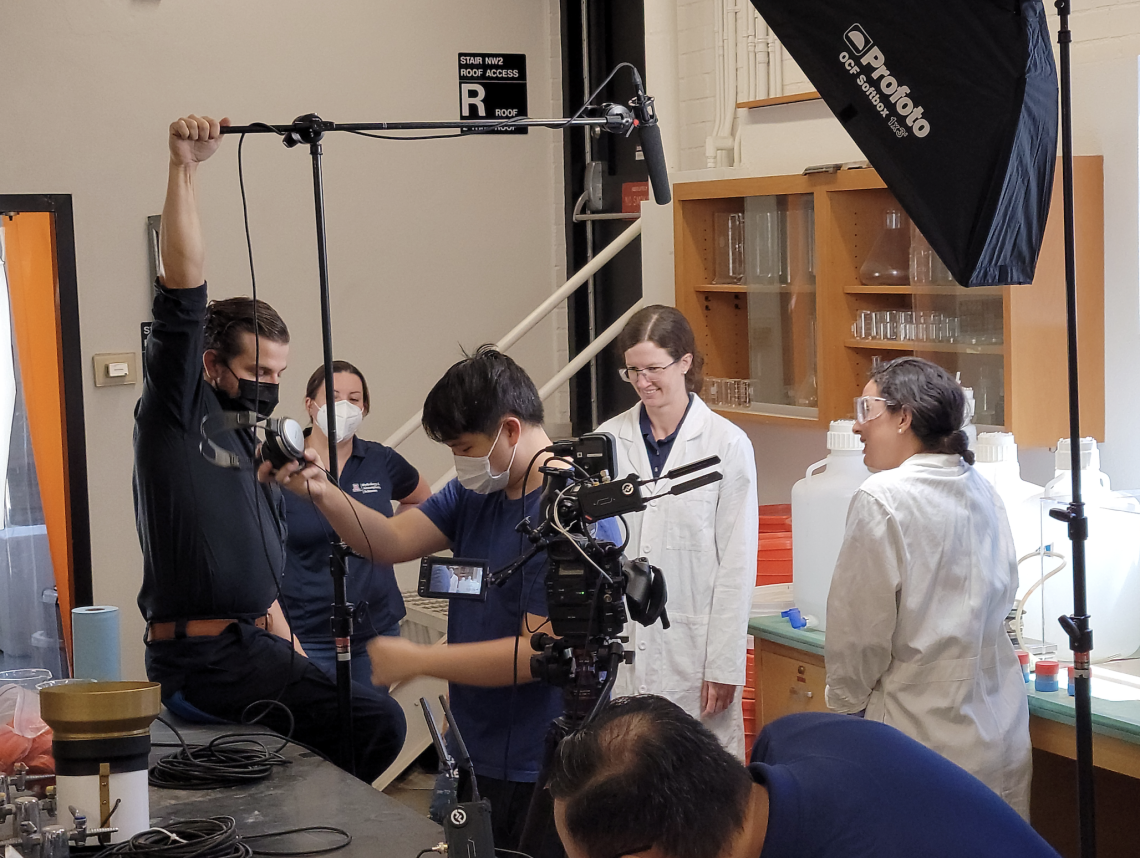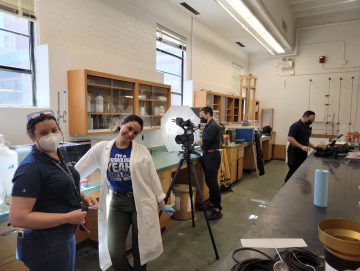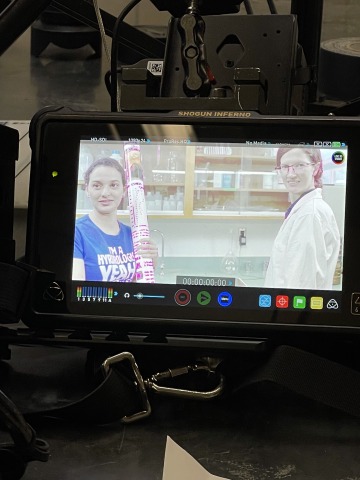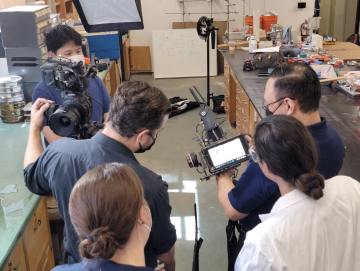Educational Video Unravels the Connection Between Water and Mining

Isabel Barton (L) and Xenia De Gracia (R) behind the scenes during the making of “Water in the Lifecycle of a Mine”
How do water and mining intersect? How do engineers and scientists manage challenges related to that intersection? Where does the water used by mines come from and how important are conservation measures to the whole process?
A recent educational video produced by the University of Arizona School of Mining & Mineral Resources (SMMR) and the UArizona Department of Hydrology and Atmospheric Sciences (HAS) answers those questions in a fun and informative way. Aided by a Mineral Resources Research and Innovation Initiative, “Water in the Lifecycle of a Mine,” which recently debuted on the UArizona SMMR YouTube channel, is an accessible six-minute dive into the complex issues surrounding water and the mining industry.

Xenia De Gracia films “Water in the Lifecycle of a Mine”
Intended to educate and inspire future mining engineers in the elementary through undergrad arena, the video connects the dots between mining and hydrology using narrative flourishes and interviews with experts that include UArizona professors as well as local engineers involved with the industry.
The original idea for the video came from the Hydrology Department’s desire to create an outreach program that exposes students to the facts surrounding hydrology and mining. Enter the video’s Executive Producer, Gillian Noonan, Senior Engineer, Research and Development at the Geotechnical Center of Excellence (GCE). “The overall goal of the video is to understand the big picture of the importance of minerals and mining and then the importance of water in the mining process,” Noonan, who has a background in geological engineering and hydrology, says. “We also wanted to overview the ways that engineers and scientists manage the challenges related to water and mining, for example, slope stability, water balance, and environmental monitoring.”

Xenia De Gracia (L) and Isabel Barton (R) make “Water in the Lifecycle of a Mine”
Knowing that waste and environmental carelessness are common misconceptions about the modern mining industry, Noonan wanted to help set the record straight. A big focus of the video is the reality that mines share and use water responsibly in Arizona. “It showcases the responsibility of mines to share a scarce resource,” Noonan says. “It involves a lot of regulation and it's something that they take very seriously.”
Noonan met with producer and videographer John Z. de Dios, co-founder of Davis de Dios Media, who suggested a novel approach to the video’s structure. Expert interviews could be framed by a scripted scenario where a student is asked by her professor to create a research poster about the relationship between water and mining. “It was a meaningful experience because it allowed me to draw from my background as a former journalist,” de Dios says. “And it allowed me to continue expanding into scripted narrative projects while also working with a passionate and creative group of people.”
The student and professor’s playful interaction opens and closes the video, sandwiched around interviews with experts Hannah Eppard of Piteau Associates, Colin Kikuchi of Montgomery & Associates, the late Tom Meixner, UArizona Hydrology and Atmospheric Sciences Dept. Head, and Brad Ross, Co-Director, Geotechnical Center of Excellence, School of Mining and Mineral Resources.
“That broad collaborative aspect was a very positive element,” Noonan says. “Working for the GCE and being a student in hydrology with a mining background, one of my goals was to provide a bridge from the hydrology department to the university at large as well as our industry partners. We have a mining engineering department here at UArizona, but mining also relates to so many other departments across the university, including hydrology, accounting, civil engineering, geology, data science, and mechanical engineering, to name a few.”
Environmental Sciences graduate student Xenia De Gracia plays the role of the inquisitive student, and Assistant Professor of Mining and Geological Engineering Isabel Barton takes the role of professor and mentor. As a student learning about the subjects covered in the video, De Gracia is proud of her part in the production. “Being part of this project was meaningful to me because it helps to explain to a public of different ages and backgrounds how water is used during the lifecycle of a mine,” she says. “This is why students like me are getting specialized to help take care of these water sources while they are used to get the minerals that are so important for decarbonization, for example.”

Making “Water in the Lifecycle of a Mine”
In its goal to educate and attract young people to the importance of mining in everyday life, and the environmental responsibilities that accompany the task, “Water in the Lifecycle of a Mine,” provides a high-level overview of how water is sourced and used for mining, how uncontrolled water is managed in mines, and what water-related actions are continued when a mine is finished mining.
Not only does the video shed light on the intricate dance between water and mining but it also serves as a testament to the collaborative efforts of educators, engineers, and scientists in demystifying the industry. By bridging the gap between hydrology and mining, the video breaks down misconceptions and emphasizes the responsible and regulated use of water in Arizona's mining practices. “Water in the Lifecycle of a Mine,” is a call to appreciate the intersection of water and mining, fostering a generation of mindful professionals ready to navigate the challenges and opportunities that lie ahead in the ever-evolving world of mineral resources.
“As someone who works in mining, I know that many people have negative ideas about mining, particularly when it comes to water and the environment,” Noonan says. “I understand the importance of critical minerals to the things we do and use in our daily lives, so I wanted to get that positive message across. It's something that can benefit everyone.”

